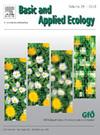瓜类植物对地上或地下食草昆虫的防御是不同的,并受生态进化因素的影响
IF 3.5
2区 环境科学与生态学
Q2 ECOLOGY
引用次数: 0
摘要
植物对食草昆虫的防御策略大致分为抗性和耐受性。抗性阻碍昆虫生长或取食,而耐受性减轻草食对植物适应性的负面影响。植物对抗性或耐受性策略的投资可能是由生态进化因素形成的连续体,例如植物驯化或与食草动物的共存历史。相对而言,人们对地上的叶状食草动物和地下的根状食草动物的一般防御策略有何不同知之甚少。本研究研究了葫芦科植物对地上壁虱(Anasa tristis)和地下条纹黄瓜甲虫(Acalymma vittatum)的防御策略。本研究选择了6种不同驯化状态和与食草动物共存历史的葫芦属植物:西葫芦(Cucurbita pepo subsp);浆果);德州葫芦(葫芦属)texana);南瓜(Cucurbita maxima);水瓜(葫芦);黄瓜(黄瓜);和西瓜(Citrullus lanatus)。对每种植物和草食组合分别进行抗性和耐受性测定。我们还进行了田间试验,以研究长期草食对植物生殖和营养生长的影响。我们观察了瓜类植物对地上和地下草食的抗性差异。在不同的物种中,植物通常比地上的植物更能忍受地下的草食。我们确定野生植物比驯化的对应物更能抵抗地上而不是地下的草食。此外,具有草食共存历史的植物对地上和地下草食的抗性都低于没有草食共存历史的植物。在田间长期草食条件下,西葫芦植株对地上或地下草食的耐受性均优于西瓜植株。总的来说,我们的研究结果突出了植物对地上和地下食草动物的防御差异,促进了对影响植物防御策略的生态进化因素的理解,并为葫芦的农业有害生物管理提供了新的见解。本文章由计算机程序翻译,如有差异,请以英文原文为准。
Cucurbit plant defenses against aboveground or belowground insect herbivores are distinct and shaped by eco-evolutionary factors
Plant defense strategies against insect herbivores are classified broadly as resistance or tolerance. Resistance deters insect growth or feeding, while tolerance mitigates negative effects of herbivory on plant fitness. Plant investment into resistance or tolerance strategies likely falls along a continuum that has been shaped by eco-evolutionary factors, such as plant domestication or coexistence histories with herbivores. Relatively little is known about how general defense strategies differ against aboveground foliar herbivores and belowground root herbivores. In the current study, we investigated defense strategies of plant species in the gourd family (Cucurbitaceae) against aboveground squash bug (Anasa tristis) or belowground striped cucumber beetle (Acalymma vittatum) herbivory. We selected six cucurbit plant species that differed in domestication status and coexistence history with herbivores: zucchini squash (Cucurbita pepo subsp. pepo); Texas gourd (Cucurbita pepo subsp. texana); pumpkin (Cucurbita maxima); buffalo gourd (Cucurbita foetidissima); cucumber (Cucumis sativus); and watermelon (Citrullus lanatus). For each plant species and herbivore combination, we conducted separate resistance and tolerance assays. We also carried out a field experiment to examine how longer-term herbivory influences plant reproductive and vegetative growth. We observed variation in resistance among cucurbit plant species against aboveground and belowground herbivory. Across species, plants were generally more tolerant of herbivory belowground than aboveground. We determined that wild plants were more resistant than domesticated counterparts to herbivory aboveground but not belowground. Further, plants with an herbivore coexistence history were less resistant to herbivory aboveground and belowground compared to those without. With longer-term herbivory in the field, zucchini plants were more tolerant of either aboveground or belowground herbivory than watermelon plants. Collectively, our findings highlight differences in plant defense against aboveground and belowground herbivores, advancing understanding of the eco-evolutionary factors shaping plant defense strategies and providing new insights for agricultural pest management in cucurbits.
求助全文
通过发布文献求助,成功后即可免费获取论文全文。
去求助
来源期刊

Basic and Applied Ecology
环境科学-生态学
CiteScore
6.90
自引率
5.30%
发文量
103
审稿时长
10.6 weeks
期刊介绍:
Basic and Applied Ecology provides a forum in which significant advances and ideas can be rapidly communicated to a wide audience. Basic and Applied Ecology publishes original contributions, perspectives and reviews from all areas of basic and applied ecology. Ecologists from all countries are invited to publish ecological research of international interest in its pages. There is no bias with regard to taxon or geographical area.
 求助内容:
求助内容: 应助结果提醒方式:
应助结果提醒方式:


